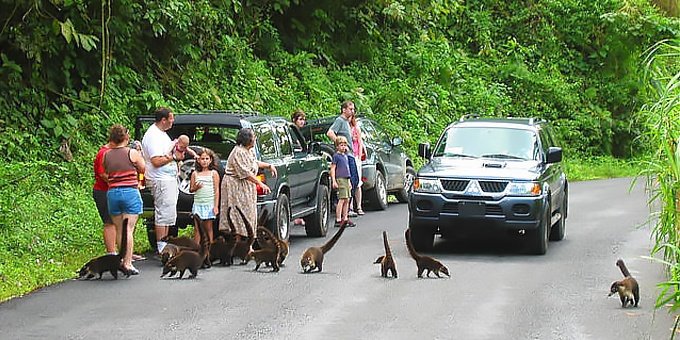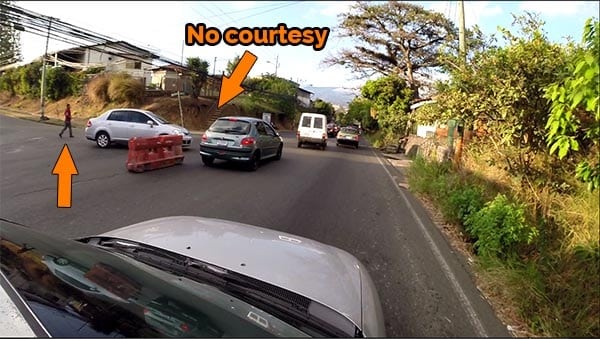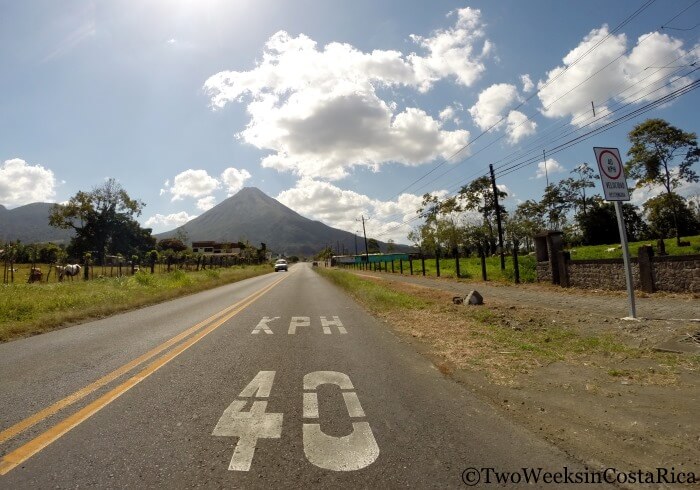Driving in Costa Rica offers a unique adventure. The country’s roads reveal stunning landscapes and vibrant culture.
Costa Rica is a land of diverse beauty. From lush rainforests to pristine beaches, the scenery is captivating. Driving here lets you explore at your own pace. But it’s not just about the views. Understanding the local driving culture is key.
Roads can be narrow and windy. Traffic signs might be in Spanish. Local drivers might seem assertive. But don’t worry. With preparation, driving can be smooth and enjoyable. Renting a car gives you freedom. You can visit remote areas and hidden gems. Plus, public transport doesn’t reach every corner. So, buckle up and get ready for an unforgettable journey through Costa Rica’s stunning landscapes.

Credit: www.twoweeksincostarica.com
Road Conditions
Costa Rica’s road conditions can vary greatly, affecting your travel experience. Exploring this beautiful country by car requires some understanding of the roads. Knowing what to expect helps in planning a smooth and enjoyable journey.
Paved And Unpaved Roads
Most main roads in Costa Rica are paved. These roads connect major cities and tourist destinations. The paved roads are generally in good condition. Driving on them is straightforward. Expect some potholes and uneven patches in places.
Unpaved roads are common in rural areas. These roads can be challenging to navigate. They lead to beaches, mountains, and remote spots. Gravel and dirt roads are typical. A 4×4 vehicle is often recommended for these routes.
Weather Impacts
Weather affects road conditions in Costa Rica. Heavy rains can create muddy and slippery surfaces. This is especially true for unpaved roads. The rainy season lasts from May to November. Travelers should be cautious during this time.
Flooding can occur, blocking certain roads. Landslides are a risk in mountainous areas. It’s important to check weather forecasts before traveling. Dry season offers more predictable road conditions. This season runs from December to April.

Credit: www.entercostarica.com
Navigating Terrain
Driving in Costa Rica offers breathtaking views and unique challenges that make every journey an adventure. Navigating the diverse terrain requires both preparation and adaptability. From the towering peaks of the mountainous regions to the serene coastal drives, each road tells its own story. You’ll find that understanding these landscapes can enhance your travel experience significantly. Are you ready to discover what makes driving here so distinct?
Mountainous Regions
The mountainous regions of Costa Rica are a sight to behold. Picture winding roads that offer panoramic views of lush valleys and distant volcanoes. You might encounter narrow paths and steep inclines that test your driving skills. It’s important to keep your vehicle well-maintained, especially the brakes and tires. Consider renting a 4×4 vehicle for better control and stability.
Driving through these areas can be slow but immensely rewarding. You’ll find yourself stopping frequently just to soak in the stunning vistas. It’s not uncommon to encounter local wildlife crossing the road, adding a touch of nature to your trip. How will these unexpected encounters shape your journey?
Coastal Drives
The coastal drives in Costa Rica offer a different kind of magic. Imagine cruising along roads where the ocean is just a stone’s throw away. The sound of waves crashing and the salty breeze make for an unforgettable experience. These roads are often more straightforward, but watch out for occasional potholes.
Parking near beaches can be tricky during peak hours. It’s wise to arrive early or opt for less crowded spots. Many of these coastal routes lead to hidden gems, such as secluded beaches and charming seaside towns. Will you take the time to explore these hidden treasures?
As you navigate Costa Rica’s terrain, remember that each route offers its own set of surprises. Adaptability and a sense of adventure are your best companions on these roads. Whether you’re scaling mountains or hugging the coastline, every drive is an opportunity to discover something new. Are you ready to embrace the journey?
Car Rental Tips
Renting a car in Costa Rica offers freedom and adventure. Travelers can explore beautiful landscapes at their own pace. Understanding car rental tips can enhance this experience. Knowing how to choose the right vehicle and insurance is vital. It ensures a smooth and stress-free journey.
Choosing The Right Vehicle
Consider the terrain before picking a car. Costa Rica has diverse landscapes. Some roads are paved, others are rugged. A 4×4 vehicle is best for mountainous areas. It handles rough roads with ease. For city driving, a compact car is ideal. It is easy to park and economical. Remember to check the vehicle’s condition. Ensure the tires and brakes are in top shape. This guarantees safety during your travels.
Rental Insurance
Protecting yourself with rental insurance is crucial. Costa Rica requires basic liability coverage. This covers third-party damage. Consider purchasing additional coverage. It safeguards against theft and accidents. Check what your credit card offers. Some cards include rental insurance. Verify with your provider before declining coverage. This could save money and hassle. Always read the insurance terms carefully. Understand what is covered and what isn’t.
Traffic Laws
Driving in Costa Rica offers stunning views and unique experiences. Knowing the traffic laws ensures a safe journey. These laws can be different from your home country. Understanding them helps avoid fines and accidents.
Speed Limits
Speed limits in Costa Rica vary by area. Urban areas usually have a 40 km/h limit. Residential zones often set limits at 25 km/h. On highways, the speed limit can be 80 to 100 km/h. Always pay attention to posted signs. Speed cameras monitor many roads. Exceeding limits can result in fines.
Signage And Signals
Road signs in Costa Rica use international symbols. They are mostly in Spanish. Familiarize yourself with common terms like “Alto” for stop. Traffic lights function like those in other countries. Green means go, red means stop, yellow signals caution. Roundabouts are frequent in Costa Rica. Yield to traffic already inside the circle.
Driving Etiquette
Driving in Costa Rica requires patience and awareness. Roads can be narrow and winding. Local drivers may not always follow strict rules.
Driving in Costa Rica can be an adventure, filled with picturesque landscapes and vibrant local culture. However, to make your journey smoother, understanding the driving etiquette is essential. It’s not just about following rules; it’s about respecting the unwritten codes that locals abide by. Knowing these can transform your driving experience from stressful to enjoyable. Are you ready to dive into the nuances of Costa Rican driving habits?
Local Driving Habits
Costa Rican drivers often exhibit a relaxed approach on the roads. You might notice a tendency to drive slightly under the speed limit or make frequent stops to chat with friends. This casual attitude can be surprising, especially if you’re used to more fast-paced driving environments.
Drivers often use their hazard lights as a way to signal various intentions. It could mean they’re about to make a sudden stop or are facing an unexpected obstacle. Always stay alert and be prepared to react accordingly.
Roundabouts, or “rotondas,” are common, and the priority is typically given to those already in the circle. However, yielding is not always guaranteed. Keep an eye on all entry points and proceed with caution.
Dealing With Pedestrians
Pedestrians in Costa Rica often cross the road wherever and whenever they please. While there are designated crosswalks, not everyone uses them. Always be on the lookout for people darting across the street, especially in busy areas or near bus stops.
In smaller towns, locals may expect you to stop for them, even if they are not at a crosswalk. This can be a bit unsettling but is seen as a common courtesy. A friendly wave can go a long way in such situations.
Nighttime driving requires extra vigilance. Many roads are poorly lit, and pedestrians might not be visible until the last moment. Consider using your high beams where appropriate but be courteous and dim them for oncoming traffic.
Driving in Costa Rica might require a bit of adjustment, but it also offers a unique chance to engage with local customs. By understanding and respecting these unwritten rules, you can ensure a smoother, more enjoyable journey. Have you had any surprising experiences while driving in foreign countries? How did you adapt?

Credit: mytanfeet.com
Safety Precautions
Driving in Costa Rica requires extra caution due to winding roads and unpredictable weather. Always wear seatbelts and keep headlights on. Stay alert for wildlife crossing roads, especially in rural areas.
Driving in Costa Rica can be an exhilarating adventure, offering breathtaking views and unique experiences. However, it’s crucial to prioritize safety to ensure your journey is enjoyable and trouble-free. Navigating unfamiliar roads and encountering unexpected situations can be daunting, but with the right precautions, you can stay safe and make the most of your trip. Remember, preparation is your best ally.
### Emergency Contacts
Costa Rica is known for its friendly locals, but knowing whom to contact in an emergency is vital. Have the local police and ambulance numbers saved in your phone. The national emergency number is 911, just like in the United States.
Consider having the contact details of your country’s embassy or consulate in Costa Rica. They can be a great resource in case of serious issues.
You might not plan for mishaps, but having these contacts readily available can make a significant difference if things go awry.
### Roadside Assistance
Imagine you’re driving along a remote mountain road and your car breaks down. Having roadside assistance can be a lifesaver.
When renting a car, check if the rental company offers roadside assistance. Some companies include it in their packages, while others might charge extra.
Another option is to purchase a local SIM card with data. This allows you to access maps and contact help if needed. You never know when you’ll need a quick solution.
Costa Rica’s roads can be unpredictable. Being prepared with roadside assistance ensures you’re not left stranded in an unfamiliar place.
Fuel And Gas Stations
Costa Rica’s fuel and gas stations are vital for travelers exploring its scenic routes. Stations are widely available, ensuring drivers can refuel easily. They often offer basic amenities, making road trips convenient.
Driving in Costa Rica can be an adventure, and understanding the ins and outs of fuel and gas stations is key to a smooth journey. Whether you’re navigating the bustling streets of San José or exploring the serene landscapes of Guanacaste, knowing where and how to refuel your vehicle is essential. This guide will help you find fuel stations and understand the payment options available in Costa Rica, ensuring your road trip is as seamless as possible.
Finding Fuel Stations
Costa Rica has a good number of fuel stations scattered across its regions. In cities like San José, you’ll find them quite easily, often within a few kilometers of each other. However, in rural areas or along coastal routes, gas stations can be more spread out.
Plan your route and keep an eye on your fuel gauge. Google Maps and Waze are helpful tools that can show you nearby gas stations. They even provide real-time updates on fuel prices and opening hours.
Gas stations in Costa Rica are typically open from 6 AM to 10 PM. However, in tourist-heavy areas, you might find some open 24/7. It’s always a good idea to fill up your tank when you spot a station, especially if you’re embarking on a long drive through less populated areas.
Payment Options
Most gas stations in Costa Rica accept both cash and credit cards, making it convenient for travelers. However, it’s wise to carry some cash, preferably in Costa Rican colones, as smaller or rural stations might not accept cards.
When you arrive at a station, a friendly attendant usually assists with refueling. Let them know how much fuel you want in liters or colones, and they’ll handle the rest. Tipping is not mandatory, but a small tip is appreciated for excellent service.
Keep an eye on the card transactions. Some travelers have reported unauthorized charges. Ensure the transaction amount matches the fuel you’ve received before leaving the station.
Have you ever found yourself in a remote area, low on fuel, and wondering where the next gas station might be? Planning ahead can prevent these nerve-wracking situations. Your Costa Rican adventure should be filled with exploration, not fuel anxiety.
Preparing For The Journey
Driving in Costa Rica offers breathtaking views and unique experiences. To make the most of your adventure, preparation is key. This guide will help you plan your trip efficiently and ensure a smooth journey.
Packing Essentials
Start with clothing suitable for Costa Rica’s tropical climate. Lightweight, breathable fabrics work best. Don’t forget a rain jacket, as showers are common. Sunscreen and insect repellent are crucial for comfort and protection. A reusable water bottle keeps you hydrated on long drives. Pack snacks for energy boosts and a first-aid kit for emergencies.
Bring a reliable map or GPS device. Internet connection can be spotty in remote areas. A power bank ensures your devices stay charged. Consider packing a Spanish phrasebook. It helps in communicating with locals.
Route Planning
Research your routes before setting off. Some roads can be challenging. Costa Rica’s terrain varies from smooth highways to rugged mountain paths. Use online resources to check road conditions and traffic updates. Plan your stops at popular attractions along the way.
Include time for breaks and sightseeing. This prevents fatigue and enhances your travel experience. Remember, many roads have tolls. Keep some cash handy for these. Check the weather forecast to avoid driving in heavy rain.
Consider the time of day for your drive. Early starts help you avoid traffic and enjoy cooler temperatures. Make sure your rental car is suitable for your planned routes. A 4×4 vehicle is ideal for off-road adventures.
Conclusion
Driving in Costa Rica offers unique experiences and challenges. Roads wind through breathtaking landscapes. Local driving customs might seem unfamiliar at first. Stay alert and be patient. Renting a car gives you freedom to explore. Dive into local culture, far from tourist spots.
Remember, rainy season affects road conditions. Plan routes considering weather forecasts. Always have a map or GPS handy. Respect traffic laws for a safe journey. With careful planning, your Costa Rica adventure will be memorable and smooth. Enjoy the vibrant scenery and welcoming people.
Embark on your Costa Rican road trip with confidence. Safe travels!











